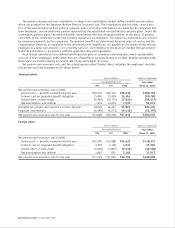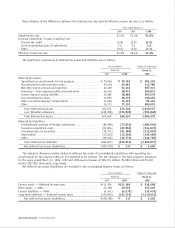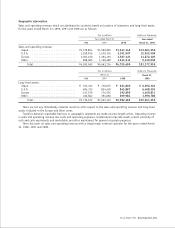Sony 1998 Annual Report Download - page 72
Download and view the complete annual report
Please find page 72 of the 1998 Sony annual report below. You can navigate through the pages in the report by either clicking on the pages listed below, or by using the keyword search tool below to find specific information within the annual report.[70] Sony Corporation Annual Report 1998
18. Commitments and contingent liabilities
Commitments outstanding at March 31, 1998 for the purchase of property, plant and equipment and other assets
approximated ¥54,474 million ($412,682 thousand).
Contingent liabilities for guarantees given in the ordinary course of business and for employee loans amounted
to ¥123,065 million ($932,311 thousand) at March 31, 1998.
The company has entered into agreements with financial institutions whereby the company can sell specifically
identified accounts receivable and future receivables with limited recourse. For the years ended March 31, 1996,
1997 and 1998, the company did not sell any specifically identified accounts receivable or future receivables. As of
March 31, 1997 and 1998, the outstanding balance of all receivables sold with limited recourse amounted to ¥868
million and ¥0 million ($0 thousand), respectively.
The company has also entered into agreements with financial institutions whereby the company can sell up to
¥125,400 million ($950,000 thousand) of undivided interests in a pool of eligible receivables with limited recourse.
The maximum pool of eligible receivables sold outstanding at any one time during the years ended March 31, 1996,
1997 and 1998 amounted to ¥71,868 million, ¥0 million and ¥0 million ($0 thousand), respectively. As of March 31,
1997 and 1998, there were no outstanding balances of receivables sold.
Under the terms of each of the receivable sale agreements, the company has retained substantially the same risk
of credit loss as if the receivables had not been sold. The company has fully reserved for these potential credit
losses. The company pays fees which approximate the purchasers’ costs of issuing commercial paper and are included
in other expense.
Certain subsidiaries in the music business entered into long-term contracts with recording artists and companies
for the production and/or distribution of prerecorded music and videos. These contracts cover various periods mainly
through March 31, 2001. As of March 31, 1998, these subsidiaries were committed to make payments under such
long-term contracts of ¥24,211 million ($183,417 thousand).
The parent company and certain of its subsidiaries are defendants in several pending lawsuits. However, based
upon the information currently available to both the company and its legal counsel, management of the company
believes that damages from such lawsuits, if any, would not have a material effect on the company’s consolidated
financial statements.
19. Business segment information
Effective for the year ended March 31, 1998, the company adopted FAS 131, “Disclosures about Segments of an
Enterprise and Related Information” which requires disclosure of financial and descriptive information about the
company’s reportable operating segments. The operating segments reported below are the segments of the company
for which separate financial information is available and for which operating profit/loss amounts are evaluated
regularly by executive management in deciding how to allocate resources and in assessing performance.
The operating segment information reported below differs from the industry segment information previously
disclosed under FAS 14, “Financial Reporting for Segments of a Business Enterprise” in that the Game business was
previously included in the Electronics segment, the Music and Pictures businesses were previously combined in the
Entertainment segment, and the company’s financing operations, which were previously in the Insurance and financ-
ing segment, are now included as part of the Other segment below. The operating segment information, as well as
geographic data, for previous years have been reclassified to conform to the segment presentation for the year
ended March 31, 1998.
The Electronics segment develops, designs, manufactures and distributes audiovisual equipment, instruments and
devices throughout the world. The Game segment develops, designs and sells PlayStation game consoles and related
software mainly in Japan, the United States and Europe, and licenses to the third party software developers. The
Music segment is mainly engaged worldwide in the development, production, manufacture, and distribution of
recorded music, in all commercial formats and musical genres. The Pictures segment develops, produces, and manu-
factures image-based software, including film, video, and television mainly in the United States, and in their mar-
keting worldwide. The Insurance segment represents insurance-related underwriting business, primarily individual
life insurance business in the Japanese market. The Other segment consists of other various operating activities
primarily including customer financing and leasing business, and media-communication network businesses relating
to broadcasting and information technology. The company’s products and services are generally unique to a single
operating segment.






















